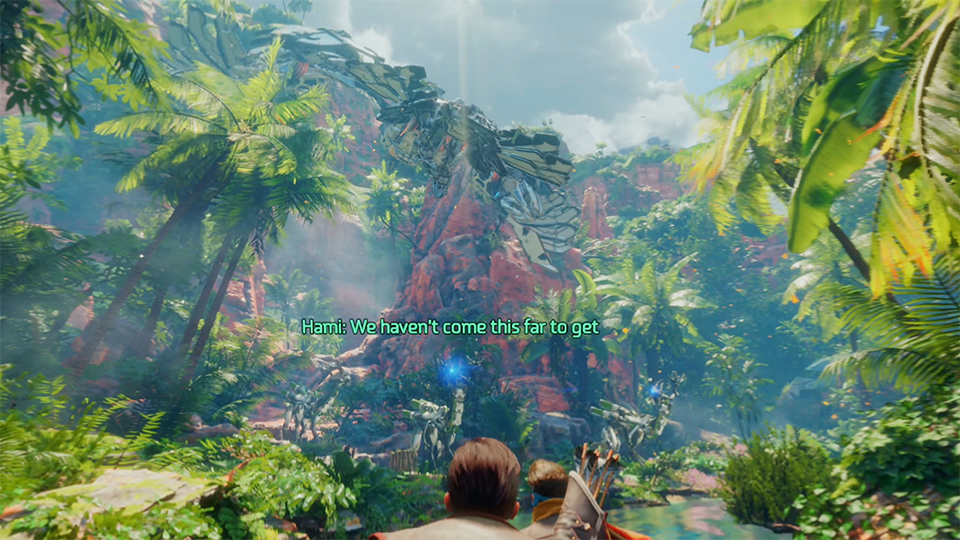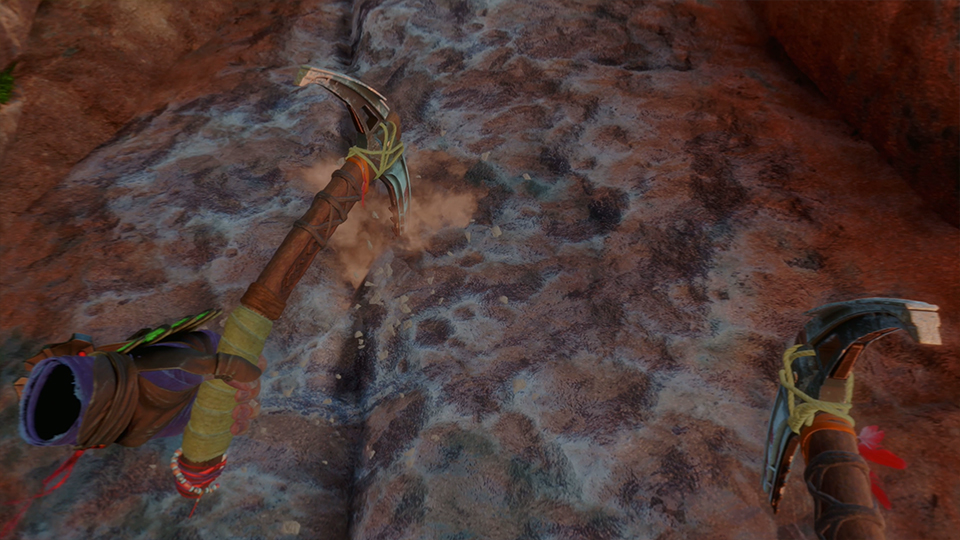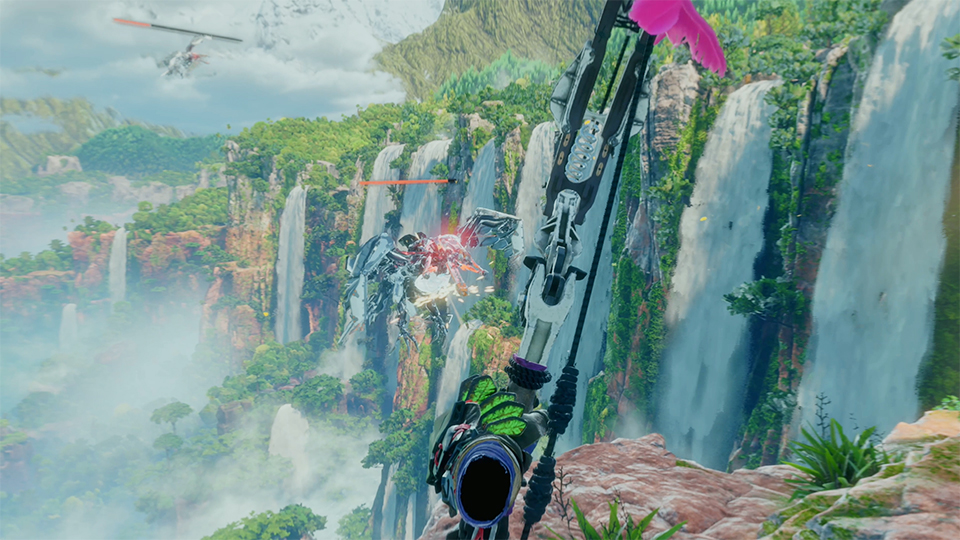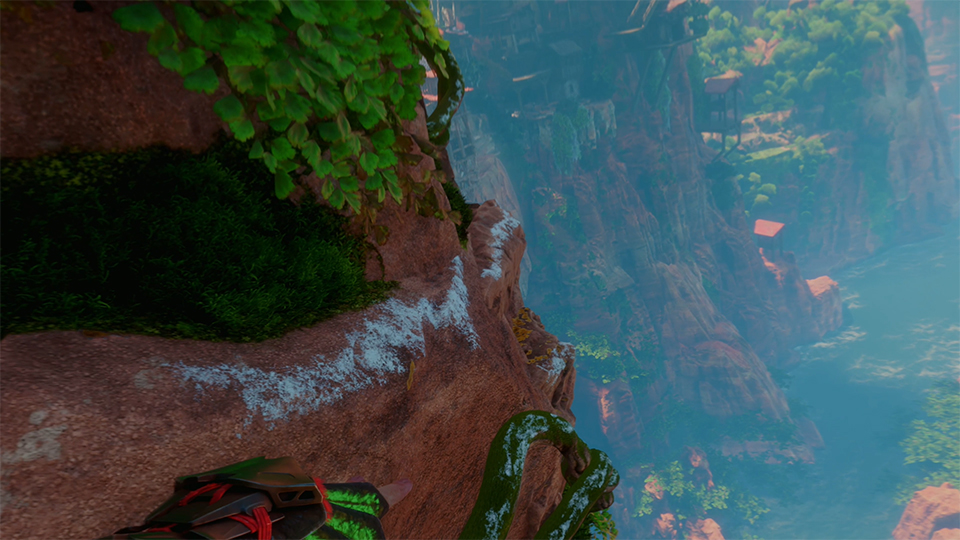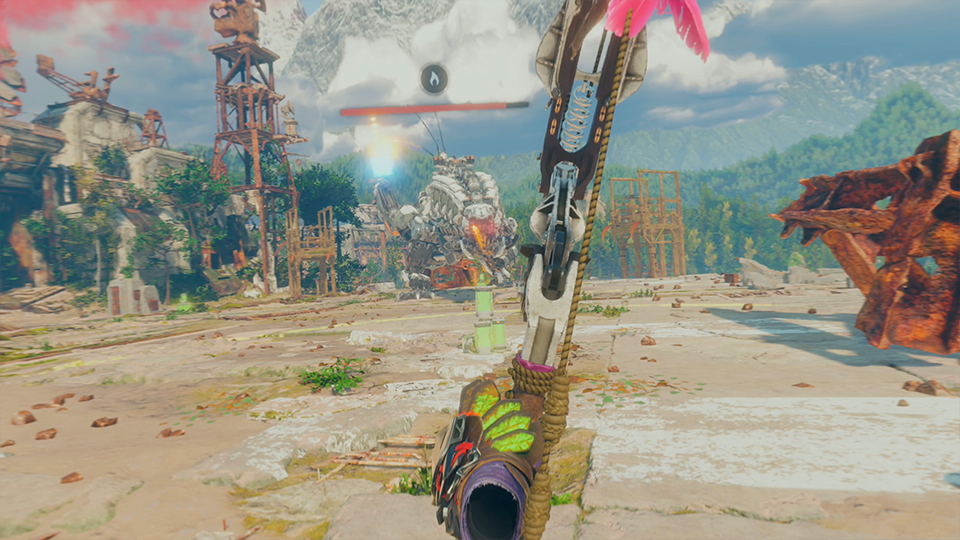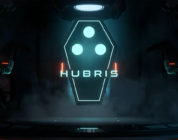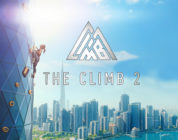Developer / Publisher – Firesprite, Guerilla Games / SIE
Price – US $59.99 / CA $79.99 / EU €59.99 / UK £49.99
Release Date – February 22, 2023
Input – 2 x Sense Controllers
Play Area – Seated, Standing, Roomscale
Store Links – PlayStation
Reviewed on – PS5/PSVR 2
I have dabbled in the Horizon franchise so I’m not entirely unfamiliar with this strange future where dangerous machines in the shape of animals roam the landscape and small groups of people sruvive while using some of the tech from the ‘old ones’, who caused a massive war that devastated the world hundreds of years earlier. In Call of the Mountain, you don’t play as Aloy, the main character from the flat games, but as Ryas, an ex Carja soldier who has been disgraced and banished for his past associations. However, as a climber your skills are needed by a small tribe and with the promise of redemption should you succeed, you embark on a perilous journey to find one of the villages missing people and make some unnerving discoveries along the way.
For those looking for the 3rd person action from the flat games, this is not here and instead you control Ryas in typical 1st person VR fashion. After surviving a deadly river ride, you’ll have to scrounge for nearby supplies and arm yourself with the weapons and tools you’ll need to fend off machines and climb to the that nearby village. A plethora of comfort options are available that I won’t breakdown here as I played with all comfort off, but for those that need assistance in VR, you are covered. When walking, you can only move at one of 3 default speeds chosen in the options as there is no way to run, which did annoy me at first as not a lot typically happens when you are allowed to free-roam on the ground, but that slower speed did allow me just to take in some impressive vistas so it didn’t bother me after too long and the fastest walk speed isn’t to bad. Climbing is the crux of this game and you’ll spend a bulk of the time in here doing just that as you initially scale these cliffsides just by hand, grabbing at any white-capped surfaces, though as you progress through the 8 hours (ish) story, new tools become available that allow you swing across gaps or even create your own zipline. I can’t stress enough that there is A LOT of climbing in here and there is no choice but to move your arms to grab at the next ledge or pull out your axe to heave yourself up flatter surfaces. At the game’s onset, when you have no tools, climbing is quite easy and while I guess it’s easy through most of the game, a few awkward choices do hamper the fun in these sections.
For starters, every new tool gets added to a wheel which you summon by pressing A or X and then using a thumbstick to highlight what you want to choose, letting a quick timer fill up before that item appears in your hand. It’s an absolutely cumbersome system that demands your full attention as whenever I looked and chose my next tool, if I looked away the game seemed to always select the tool above it. When your finished with the tool, just drop it and will fall to the ground but can be easily summoned by using that wheel once more. On more than a few occasions, that failed summoning caused me a quick death though thankfully, the auto-save system placed me back mere seconds from where I perished to let me try again. Some gaps can be jumped and are marked with symbols to remind you what you need to do and to do that, you’ll have to hold the grip buttons and swing your arm which triggers a slow motion jump which does allow you to grab a needed tool in mid air, but in situations where your just grabbing at a rope or ledge with your hands, it would have been nice to just leap and enjoy the thrills that slow motion removes. Those issues aside, the climbing here is really well done, some of the best I have ever experienced in VR in fact, as you won’t just be scaling mountains, but massive monuments, ancient buildings and just about every other structure that could be scalable. When nothing gets in the way of climbing, I enjoyed looking for my next grab point or path, moving up or down and while much of this game is linear, I was still satisfied with scaling the paths put before me.
Combat is up next and unsurprisingly, your bow will be your main choice throughout a bulk of the game as you face off against various machines from the franchise. When you square up against a foe of any size, free movement is taken away and you now can only move or dash left and right as you circle the enemy. I can see why the developers chose this system, but due to those restrictions, I found every encounter to be fairly similiar as the enemy attacks are scripted and easy to spot and thus easy to avoid while still unleashing volleys of arrows their way. You’ll face an array of smaller Watchers, flying stormbirds, a massive Thunderjaw and host more familiar machines and while these encounters might not be the most engaging at times, they are few and far between and when they did pop up, it was a typically a nice break from all the climbing. The archery also works quite well, thanks in large part to the eye tracking (which can be toggled), meaning that where you are looking is more often than not where your arrow will shoot…as long as your bow was also aimed in that general direction. Additionally, you also unlock many of the elemental arrow types from the franchise like blaze, tear and electric bolts which have additional effects or provide ongoing damage and can be crafted from parts found hidden in containers along your journey. Crafting is as simple as turning your bow flat in your hands and choosing the arrow you want to use. If you don’t have an arrow type made, you can quickly craft it by selecting it which then displays the components you need to grab and place on an arrow with all of this happening in extremely slow motion so in the heat of combat you aren’t left panicking as the enemy closes in. A blast sling also shows up in the latter half of the campaign mixing up encounters a bit as the new weapons affords even more choices while in combat.
I know I sound like I’m probably being a little harsh when it comes to each of these mechanics and while I am picking them apart and do feel like some choices made were obtuse and other mechanics could be tweaked to work better, nothing in here is broken and for the most part, works as intended. There are additional goals and interactions scattered through the game that do add to the fun and replay value as well, including multiple paths and a fun little crafting system when you need to build a new tool. In each stage, there are totems hidden throughout that can be shot for those collector hunters out there, campfires let you travel back to the Nora Village at anytime where, if it’s daytime, you can talk to the few people you have met and ask them select questions, expanding upon the story. I found a flute early on that would make noise when I brought to my mouth, a large gong was begging for me to hit it with a nearby hammer, you can build cairns that challenge you to surpass a specific height or even just paint your own mural on a nearby wall. It’s those extra little details that not only mix up the gameplay but flesh out this world in quaint and satisfying ways and every time I stumbled across the next little exercise, I had to do it! There are also challenge, arena & a tour modes to further pad the game time, but outside of the tour, the other modes didn’t really hold my interest as I much preferred the story but if you want shoot targets, run an obstacle course or enjoy more of the combat, you can!
Where Call of the Mountain is special is in the presentation and for all my complaints up to this point, powering through some of the more mundane parts will always reward you with the next ‘oh wow’ visual moment. Every single second is a spectacle whether it’s the opening boat ride when machines are around you or scaling the side of mountain as looking anywhere reveals an attention to detail we expect from non AAA VR titles making this easily one the best looking VR games to ever be made. In fact, outside of some very rare clipping way off in the distance or some texture loading after quick travelling using the campfires, what’s here is next to flawless whether you are just looking at the rockface or casting your gaze on the mountains below and above you. The machines look equally impressive up close and the larger ones are downright scary as they rip apart your surroundings while trying to attack you. The first half of the story does keep you in similar vistas but there’s enough dynamic in those that I was never once bored with my surroundings and even still, things switch up later in the game that offer up settings that I have just never seen in a game before and I honestly can’t count the amount of times I just stopped to take it all in. Everything here is on point from lighting effects, the details in dust and falling pebbles as you grab or latch onto a new surface, waterfalls, grass, villages and NPC’s with all of that ambience further being aided by the haptics in both the headset and controllers
The sense controllers are truly next level when it comes to VR and whether I was feeling the tightening of my bowstring on my fingers, the subtle ripple of water on my hand as I dipped it in a river or used my axes to climb a shear rock face, every interaction felt substantial and truly added another layer to immersion. The headset haptics are also no joke offering up more than a few jaw dropping moments like when a long neck approached with each step increasing the vibration on my head until it walked right over me, shaking my headset intensely or even in combat as my headset would always let me know if I took damage and had to seek out a nearby apple to help recoup my health. Bottom line here is the haptics in the PSVR 2 headset, when used properly, like in Call of the Mountain, can bring a game to the next level.
It’s no surprise than that with near perfect visuals comes near perfect audio design with the largest standout being the spatial audio which just adds even more life to this already beautiful world. The soundtrack might leave you alone while climbing but kicks in during battles and any other more dramatic moments, though oftentimes may be much more subtle, accentuating a peaceful view and never gets in the way or becomes to overpowering. Ryas will often talk to himself either elaborating on his feelings on whatever just happened or dropping not so subtle clues to ensure I was moving in the right direction and when in town you can briefly converse with the locals, asking them some simple questions before moving on. Bottom line here is the presentation across the board is next level and does set a new standard for VR gaming.
Call of the Mountain is not perfect game, and I think was designed to be played in smaller doses as I did find myself getting fatigued by the whole thing once I reached the halfway point, though I did play through the story in 3 longer sittings. Things do continue to mix up as the game progresses but the core dynamic of a lot of climbing, a little bit of walking and occasional combat does make up a bulk of gameplay and does feel quite samey at times. That said, powering through any repetition reveals entirely new areas to explore and views to take in and when I was enjoying what I was doing, I was enamoured with the game and couldn’t wait to see what spectacle I was going to run across next. It’s not perfect but what’s here is a treat that everyone needs to experience and thanks to that quick 5 minute boat tour, everyone can at least see where VR has come in the last 6 years. In some ways this feels like VR for beginners, which is probably who this was designed for, but there should be enough here to keep anyone entertained for the whole journey. It might be priced closer to premium non-VR games but what’s here is a showpiece and I’m looking forward to not only showing this off to others, but hopping back in to enjoy this world myself and maybe hunt down some more of the totems.
Sony provided us with a press code for this title and, regardless of this review, we thank them for that!

